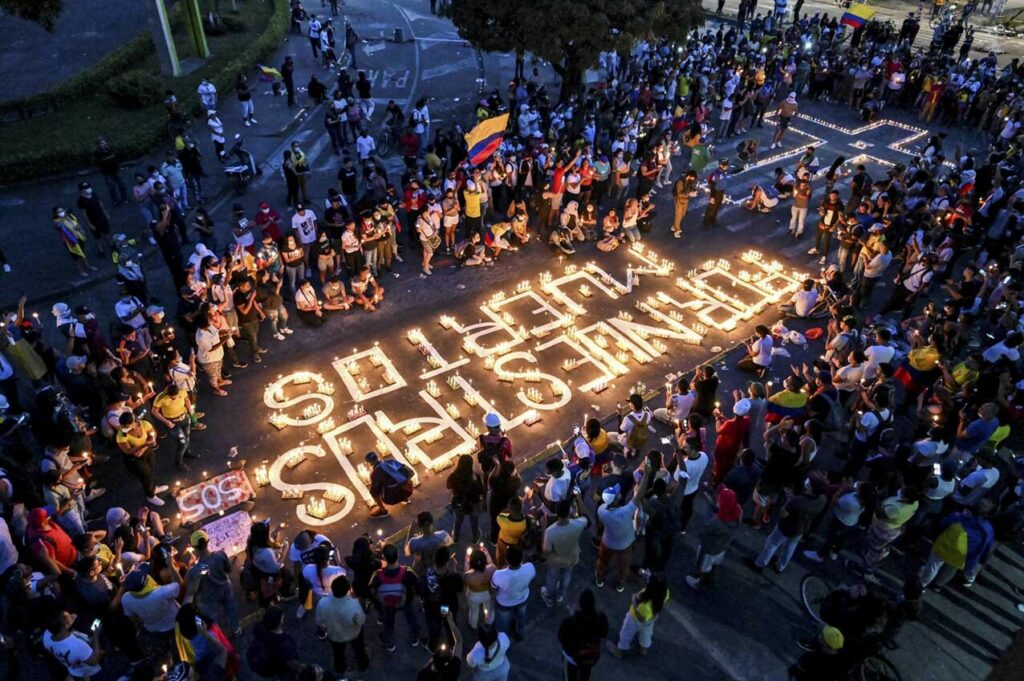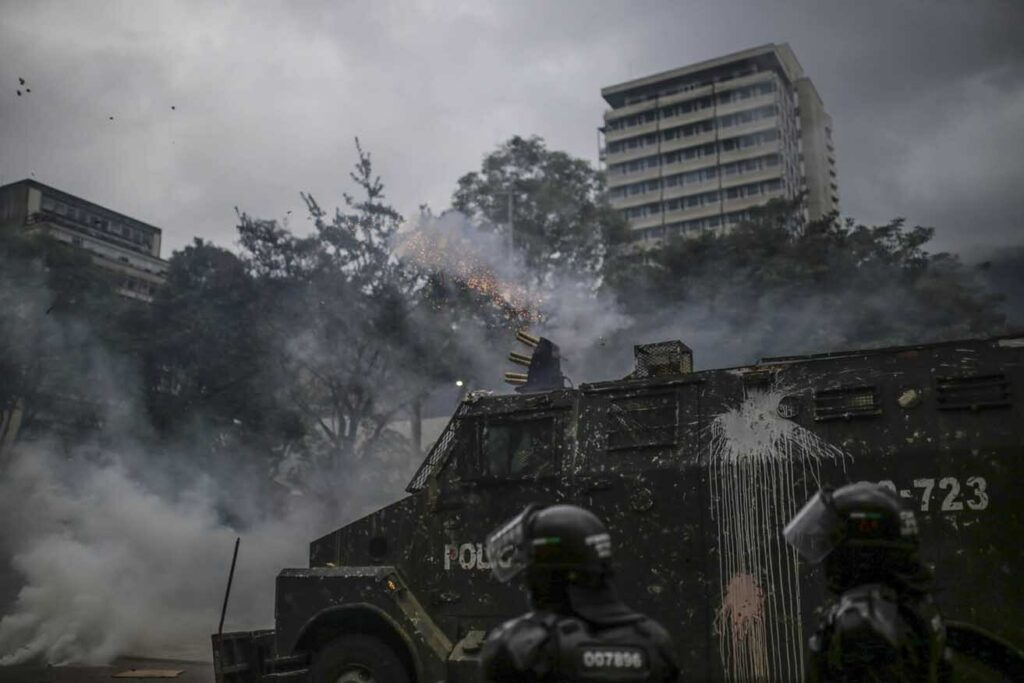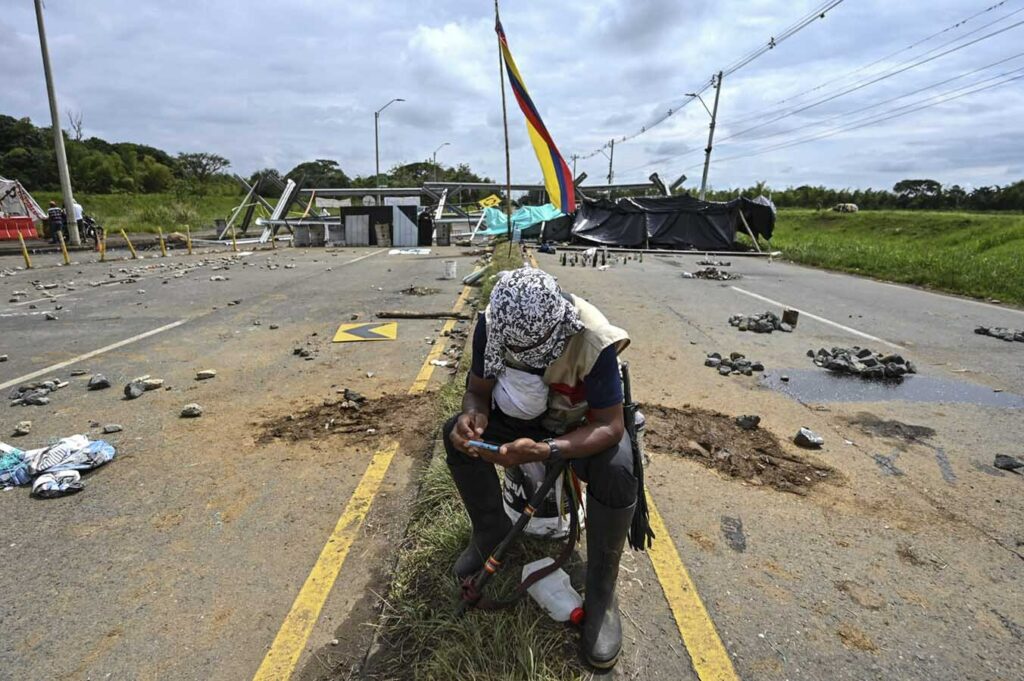Flying the flag: A protester waves the Colombian flag during strike action on the same day in Bogotá. The protests are pro-poor and articulate the feeling that the government protects the interests of the wealthy elite. Photos: Ovidio Gonzalez/Getty Images
Hundreds of thousands of Colombians have taken to the streets in ongoing protests across the country in what has turned into the most widespread mobilisation of civil unrest in recent history.
The protest movement kicked off with a general strike on 28 April in response to the government announcing a controversial tax reform that would have negatively affected millions of people who are already struggling since the start of the pandemic.
The demonstrations in the capital city, Bogotá, started out peacefully with musical performances and dancing in the streets, resembling something of a carnival, but became progressively agitated as the days passed and protesters and police began to clash.
Things reached fever pitch and took a turn for the worse on 1 May, when a group of Workers’ Day marchers made their way to the home of President Iván Duque Márquez, demanding that he resign.
Clashes with riot police ensued and the president briefed the nation that evening, announcing the militarisation of several cities and municipalities.
The following day, Duque announced he was withdrawing the tax reform and on 3 May, the minister of finance resigned.
But none of this has calmed the protesters, who are calling for grand-scale reform.
This recent round of civil uprising may have been set off by the tax bill coupled with frustration over ongoing lockdowns, closures of educational and commercial establishments, and economic hardships exacerbated by the pandemic.
But reality is that the discontent runs much deeper. Colombia is one of the most unequal countries in the world and has long battled social issues related to inequality and conflict.
 Solidarity: On a pavement in Cali, candles spell out the words “for our dead” during a vigil on 5 May in honour of the demonstrators who died during protests against the government. The current death toll is at least 45 people. Photo: Luis Robayo/AFP
Solidarity: On a pavement in Cali, candles spell out the words “for our dead” during a vigil on 5 May in honour of the demonstrators who died during protests against the government. The current death toll is at least 45 people. Photo: Luis Robayo/AFP
In 2016, former president Juan Manuel Santos signed a peace deal with the Revolutionary Armed Forces of Colombia (commonly known by their Spanish acronym, Farc), signalling an end to more than 50 years of armed conflict.
But many feel that little has changed in the past five years and are frustrated with the government’s lack of follow-through with the peace accord and failure to create education and employment opportunities, provide healthcare, and protect social leaders.
According to Colombian research NGO Indepaz, 60 social leaders and 20 Farc ex-combatants have been killed so far in 2021.
Ten days into the strike, Duque set up discussion tables, opening up space for dialogues with student groups, strike organisers and union leaders, among others. Whether the demands will be met remains to be seen. Initial demands include six months’ emergency income for 30-million people living in poverty, access to healthcare and free education.
But naysayers are questioning where this money will come from.
In a country marked by deep inequality, politics and political decisions are often polarised along class lines, with those at the higher end of the income scale seen as wanting to hold on to the status quo and those at the lower end perceived as looking for handouts.
Poverty levels in Colombia reached 42.5% — an increase of 2.8-million people living in extreme poverty — since the Covid-19 health crisis began, forcing businesses to shut down and hurting informal workers. The government is perceived as looking out for the interests of the elite and maintaining or deepening the inequality gap.
These divisions can be seen quite starkly in Colombia’s third-largest city, Cali, where bloody protests and violent clashes between residents and police have turned the poorest neighbourhoods into war zones.
Rights groups have denounced internet blackouts in these areas, which are believed to be part of a censorship campaign. Internet watchdog NetBlocks confirmed disruption to internet service in Cali last week, prompting condemnation from the UN.
Meanwhile, in the richest neighbourhoods, the protest has been more of an inconvenience, with residents voicing their annoyance at the road closures and food and fuel shortages caused by truck drivers blocking roads in and out of the city. On Sunday, as a group of indigenous people from the outlying rural areas approached the city to join the protest, residents from the richest neighbourhood decided they had had enough of the strike and the inconvenience it has caused and took matters into their own hands, opening fire on the indigenous guard. Video footage has been circulating showing the police standing by as armed civilians shoot at the group of rural dwellers. At least a dozen people were injured, the majority of them members of indigenous groups.
 Tens of thousands of Colombians have taken to the streets in demonstrations that began against a proposed tax reform but have since morphed into broader protests against the government of President Ivan Duque. The international community on Tuesday decried what the UN described as an “excessive use of force” by security officers in Colombia after numerous deaths during days of anti-government protests. (Photo by Juancho Torres/Anadolu Agency via Getty Images)
Tens of thousands of Colombians have taken to the streets in demonstrations that began against a proposed tax reform but have since morphed into broader protests against the government of President Ivan Duque. The international community on Tuesday decried what the UN described as an “excessive use of force” by security officers in Colombia after numerous deaths during days of anti-government protests. (Photo by Juancho Torres/Anadolu Agency via Getty Images)
Rural indigenous people make up about 4% of the population in Colombia and come from tens of different ethnic groups, but have less political and economic power.
Responding to pressure from the mayor of Cali, Duque paid a short visit to the southwestern city in the early hours of Monday morning to meet with high-level officials. He vowed to send additional security forces to remove the blockages and ordered the indigenous people to return to their homelands to avoid further confrontations.
To date, at least 45 people have died nationwide, 548 have been reported missing, and close to 300 cases of police violence have been registered since the start of the strike, according to local NGO Temblores.
Human rights organisations calling for calm from both sides have condemned the use of excessive force by police and the riot squad, Esmad.
For their part, protesters have been accused of vandalism and trying to set a police station alight with police officers inside.
 First nations last: Indigenous Colombians (such as the man above), who have lived on the land since about 15 000BC, make up 4% of the population and are poorer and less represented than the descendants of 16th-century settlers from Europe. Photos: Luis Robayo/AFP
First nations last: Indigenous Colombians (such as the man above), who have lived on the land since about 15 000BC, make up 4% of the population and are poorer and less represented than the descendants of 16th-century settlers from Europe. Photos: Luis Robayo/AFP
Demonstrators have also pulled down statues of figures seen as symbols of colonialism and oppression.
Government claims the demonstrations have been infiltrated by third forces — illegal armed groups involved in the cocaine trade, dissidents and guerrillas.
Solidarity marches have been taking place in cities around the world from London to Buenos Aires and New York denouncing the violence and calling for international support.